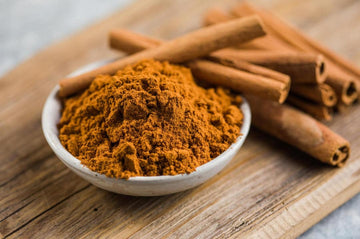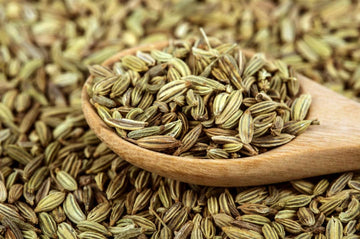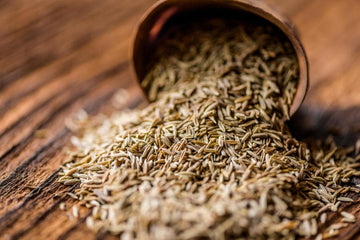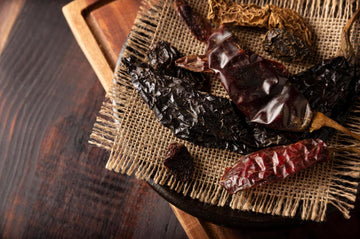Cumin is a staple in kitchens across the world, from Indian curries and Middle Eastern stews to Mexican salsas and North African spice blends. It's often one of the first spices added to a hot pan. Not just for flavor, but because of the way it sets the tone for a dish.
Nutty, earthy, slightly bitter, and unmistakably warm, cumin does a lot with just a small pinch. This article takes a closer look at cumin spice: what it is, how to prepare it, where it shows up most often in cooking, and what to reach for when you don’t have any on hand.
What is the cumin spice?
Cumin spice is made from the dried seeds of the Cuminum cyminum plant, a flowering member of the parsley family. Native to regions spanning from the eastern Mediterranean to South Asia, cumin has been cultivated for thousands of years, used both in culinary traditions and traditional medicine systems like Ayurveda and Unani.
The spice itself is typically sold in two forms: whole seeds or ground. Whole cumin seeds are oblong, ridged, and brownish-yellow, with a warm, pungent aroma that intensifies when toasted. Ground cumin is more convenient but loses its potency faster due to the increased surface area exposed to air.
Flavor-wise, cumin has a distinct profile that blends earthy bitterness with a peppery bite and a subtle citrus edge. It's not a background note, it announces itself. That’s why it's often one of the dominant flavors in a dish, particularly in spice-heavy cuisines. Cumin is also one of the defining ingredients in spice blends like garam masala, chili powder, baharat, and taco seasoning.
Culturally, cumin has played an enduring role beyond taste. It was used in ancient Egyptian embalming practices, referenced in the Bible and ancient Greek texts, and used as currency in some parts of the Middle East. Today, it's just as likely to be found in a home cook’s pantry as it is in large-scale food production.
How to prepare cumin spice?

Preparing cumin spice properly can dramatically affect its flavor, intensity, and how it interacts with other ingredients in a dish. Whether you're working with whole seeds or ground cumin, the way you store, toast, grind, and integrate it into cooking will determine how much depth it brings to your food.
Whole cumin seeds should be stored in a cool, dry, airtight container away from direct sunlight. They can last up to a year without losing much potency. Ground cumin, by contrast, has a shorter shelf life. Usually, around 3–6 months before it begins to lose its characteristic aroma and becomes flat or musty. For this reason, many experienced cooks prefer buying whole seeds and grinding them fresh.
To release their full aromatic profile, cumin seeds are often toasted before use. Toasting involves heating the seeds in a dry pan over medium heat for about 30–60 seconds, just until they darken slightly and give off a rich, nutty scent. This step awakens the oils within the seeds and deepens the flavor, especially in recipes like curries, stews, or lentil dishes. Once toasted, the seeds can be used whole or ground.
Grinding toasted cumin seeds is straightforward. You can use a traditional mortar and pestle, a spice grinder, or an electric mill. For a quick and consistent grind, tools like a salt and pepper grinder are especially useful. They offer fine control over texture and save time in the kitchen.
If you're adding cumin early in a dish (like sautéing it in oil at the beginning of a curry), whole seeds work well and infuse the cooking fat with flavor. Ground cumin, on the other hand, is typically added in the middle or later stages of cooking to build up complexity and to avoid burning the spice.
For salads, marinades, or dressings, lightly ground cumin can be whisked in for an earthy undertone without overwhelming the acidity or freshness of other ingredients. In short, how you prepare cumin should reflect both the format you’re using and the role it’s meant to play in the recipe.
Cumin spice common recipes and uses
Cumin spice plays a foundational role in cuisines around the world, thanks to its earthy warmth, slight bitterness, and savory edge. Its ability to blend into both subtle and boldly spiced dishes makes it one of the most versatile spices in any kitchen.
In Indian cuisine, cumin is often among the first spices added to hot oil to form the base of curries, dals, and vegetable stir-fries. Toasted whole cumin seeds are essential in tempering (or tadka): a cooking method where spices are briefly fried in oil to infuse it with flavor before being poured over cooked dishes. Ground cumin is also a key part of spice blends like garam masala and chaat masala, giving them their warm backbone.
In Middle Eastern cooking, cumin complements ingredients like chickpeas, lentils, and lamb. It’s common in dishes like falafel, hummus, and shawarma seasoning, where it adds depth without overpowering the freshness of herbs or acidity from lemon and yogurt.
Mexican and Latin American dishes frequently rely on ground cumin for meat rubs, chili powders, and stews like pozole or chili con carne. It enhances beans, rice, and slow-cooked proteins by tying together other spices like chili, paprika, and oregano.
In North African cuisines, cumin appears in blends such as ras el hanout or harissa, working alongside coriander, cinnamon, and fennel to season couscous, roasted vegetables, or tagines.
Beyond traditional recipes, cumin has found its way into more contemporary uses. Like seasoning roasted root vegetables, enhancing salad dressings, or even being added to craft cocktails for a smoky twist. Its warmth pairs especially well with earthy ingredients like squash, eggplant, lentils, and grilled meats.
Whether used in a dry rub, bloomed in oil, or sprinkled over finished dishes for an aromatic boost, cumin has a way of anchoring flavors while adding just enough complexity to make a dish memorable.
Cumin spice alternatives

When cumin spice isn’t available or when you're looking to shift the flavor profile of a dish slightly, several alternative spices can step in, each offering its own version of earthy warmth, smokiness, or pungency. But substituting cumin isn’t about finding a perfect one-to-one match. It's about understanding which direction you want to take the dish, and what you’re willing to gain or lose in terms of aroma, bitterness, and body.
Coriander
Coriander is the most common substitute for cumin, and for good reason: the two spices come from the same plant family and are often used together. While coriander is lighter and more citrusy, it shares cumin’s earthy backbone and can mimic its warmth when toasted. It’s a safe, versatile alternative that works exceptionally well in Indian, Middle Eastern, and Latin dishes.
Use it when: you’re preparing curries, rice dishes, or bean-based meals and want to maintain some herbal depth without overwhelming smokiness.
Caraway seeds
Caraway is frequently mistaken for cumin, especially in Eastern European and German cooking. It has a sharper, more bitter edge and a stronger anise-like undertone, but it shares cumin’s earthy, nutty quality. Toasted caraway can deliver a similar pungency and texture, particularly in bread or meat-heavy dishes.
Use it when: cooking cabbage, pork, rye bread, or pickled items where a more assertive spice can hold its own.
Fennel seeds
Fennel isn’t an obvious substitute due to its sweet, licorice-forward profile, but in the right context, especially tomato-based dishes, it can offer a compelling replacement. When lightly crushed and toasted, fennel seeds can recreate some of cumin’s aromatic complexity, though with a gentler, brighter finish.
Use it when: preparing Italian or Mediterranean dishes, or when cumin’s smoky note would be too heavy.
Smoked paprika
For dishes where cumin is used primarily for smokiness rather than earthiness, smoked paprika (especially Spanish pimentón) can be an effective substitute. It adds a deep, woodsy character and a beautiful red color, though it lacks cumin’s bitter edge.
Use it when: you’re seasoning meats, beans, or stews, and want a pronounced smoky flavor with mild sweetness.
Chili powder
Because many chili powders are blends that already contain cumin, substituting with it won’t throw off your dish too much. Just be mindful of added heat. Chili powder can add complexity through its combination of garlic, paprika, and sometimes oregano, but it’s less focused in flavor.
Use it when: making chili, tacos, or casseroles, especially if you're okay with a bit of spice and variance.
Garam masala or curry powder
These blends almost always contain cumin as part of their foundation, along with spices like turmeric, coriander, and cardamom. They aren’t subtle replacements, but if your dish leans toward Indian or South Asian cuisine, these mixes can step in while providing layered spice profiles.
Use it when: cooking lentils, rice, or meats that benefit from a more complex base.
Fenugreek seeds
Fenugreek offers a bitter, maple-like profile with a touch of sweetness and deep earthiness. Though it doesn’t taste like cumin, it provides a grounded, savory background flavor in small amounts. Be cautious, overuse can easily dominate a dish.
Use it when: you're building spice blends or stews and want to mimic some of cumin’s bitter complexity.
Oregano
Dried oregano doesn’t taste like cumin, but it does have a pungent, slightly peppery flavor that can help balance acidity or richness. Cumin often plays a role in stews, soups, or bean dishes. It won’t work everywhere, but it’s a useful stand-in in Mediterranean and Latin-inspired cooking.
Use it when: preparing sauces, marinades, or vegetable dishes where herbal bitterness is welcome.
The closest alternative to cumin spice is ground coriander. While it lacks cumin’s signature smokiness and slightly bitter edge, it shares the same earthy warmth and subtle citrus undertone. Both spices come from the same plant family and are often used together, which makes coriander a natural stand-in. Especially in dishes like curries, stews, and rice-based meals.
If your recipe relies on cumin for flavor balance rather than intensity, coriander will fill the gap with minimal disruption. However, if your dish needs more punch or smokiness, consider blending coriander with smoked paprika or a pinch of caraway to get closer to cumin’s complexity.
A must-have for every pantry
Cumin spice may be a staple in countless kitchens, but understanding how it works: its flavor profile, preparation methods, and alternatives, can help you get more intentional with your cooking.
Whether you’re toasting whole seeds for deeper aroma or using ground cumin in everyday meals, this spice offers more than just heat or earthiness; it offers balance. And when you’re out of it, knowing what can fill its place without compromising your dish is just as important. Like many ingredients, cumin is a tool. And using it well starts with knowing what it really brings to the table.
FAQs
Why does cumin sometimes taste bitter when cooked?
Cumin can develop a bitter or burnt taste when it’s toasted or fried too long, especially in oil. Whole cumin seeds should be toasted just until fragrant, usually no more than 30 seconds, to unlock their earthy aroma without crossing into bitterness. If ground cumin tastes bitter, it may be stale or overused. Always store it properly and use it sparingly in blends.
Does cumin lose potency over time?
Yes. Like most ground spices, cumin gradually loses its flavor and aroma. Ground cumin typically stays fresh for 6–12 months, while whole seeds last longer, up to 2 years if kept in an airtight container away from heat and light. Freshly grinding whole seeds right before use is the best way to maintain full flavor.
Is there a difference between black cumin and regular cumin?
Yes. Black cumin (Nigella sativa or Bunium persicum, depending on region) is a different species than common cumin (Cuminum cyminum). It has a more pungent, peppery flavor and is used differently in cooking. The seeds are smaller, darker, and often mistaken for caraway or nigella seeds, so they're not interchangeable without adjusting for flavor.
Can cumin trigger allergies or digestive issues?
While uncommon, some people may experience sensitivity to cumin, especially in large amounts. Reactions might include skin irritation, nausea, or indigestion. It can also interact mildly with certain medications. If you're trying cumin for the first time or using it in high doses (e.g., supplements or extracts), consult a health professional.









